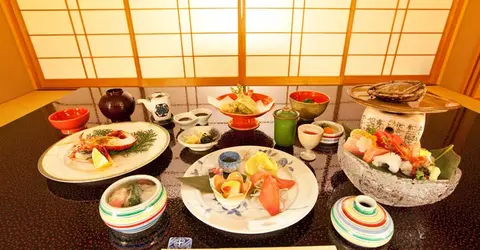Food in Japanese: Exploring the Rich and Diverse Culinary Landscape of Japan
- Published on : 27/04/2024
- by : Japan Experience
- Youtube
Japan boasts a rich and diverse culinary scene deeply rooted in history and culture. Understanding Japanese food terms is key to appreciating the nuances of the cuisine. This guide provides an overview of the main categories of food terms covered, from staples like rice and noodles to the language of dining out.
Essential Japanese Food Vocabulary: Rice, Fish, Meat, Vegetables and More
The foundation of the Japanese diet includes:
- Rice (gohan/ご飯): The quintessential staple served at nearly every meal.
- Fish (sakana/魚): Japan's island geography makes seafood, especially fish, central to the cuisine.
- Meat (niku/肉): While less common than fish, meats like beef (gyūniku/牛肉), pork (butaniku/豚肉), and chicken (toriniku/鶏肉) have their place.
- Vegetables (yasai/野菜): Each region boasts its signature seasonal vegetables.
- Soba and udon noodles are beloved staples alongside Kobe beef and fatty tuna.
Diving into Japanese Cuisine Categories: Washoku, Sushi, Tempura and Beyond
Japanese cuisine encompasses numerous categories, each with its own history and specialties:
- Washoku (和食): Traditional Japanese cuisine emphasizing seasonal ingredients and harmony with nature.
- Sushi (寿司): Vinegared rice topped or filled with fish, seafood, and vegetables.
- Sashimi (刺身): Delicate slices of raw fish or seafood served with wasabi and soy sauce.
- Tempura (天ぷら): Lightly battered, deep-fried seafood and vegetables.
- Ramen (ラーメン): Chinese-style wheat noodles in a savory broth with various toppings.
- Yakitori (焼き鳥): Grilled skewers of chicken, vegetables, and other ingredients.
- Kaiseki ryori (懐石料理): A traditional multi-course dinner embodying the essence of Japanese haute cuisine.

Set of sushi
Beverages in Japanese: From Green Tea to Sake
No Japanese meal is complete without the perfect beverage. Essential drinks include:
- Green tea (ocha/お茶): The most common type of Japanese tea.
- Sake (日本酒): A rice wine that pairs well with many dishes.
- Beer (ビール): Japan produces several popular domestic brands.
Japanese Dining Etiquette: Key Phrases and Customs to Know
Navigating a Japanese dining experience involves understanding key etiquette and phrases:
- いただきます (Itadakimasu): Say this before eating to express gratitude for the meal.
- ごちそうさまでした (Gochisousama deshita): Use this after finishing to thank the host or chef.
- お箸 (Ohashi): The Japanese word for chopsticks. Avoid pointing with them or sticking them upright in rice.
- Slurping noodles is considered a sign of enjoyment, not poor manners.
- Pour drinks for others before filling your own glass, especially when drinking sake.
Exploring Regional Specialties and Local Delicacies Across Japan
Each region of Japan boasts its own unique dishes and ingredients shaped by local geography and traditions. Notable regional specialties include:
- Osaka: Known for octopus balls in batter (takoyaki) and savory pancakes (okonomiyaki).
- Japanese pottery from Fukui Prefecture boasts national fame and a long history.
- Nabe hot pot dishes vary by region, incorporating local ingredients and flavors.
- Miso production styles and flavors differ throughout Japan, from sweet saikyo miso in Kyoto to rich hatcho miso in Aichi.
Japanese Sweets and Snacks: Traditional Wagashi to Modern Treats
Japanese confectionery, or wagashi (和菓子), encompasses traditional sweet treats often served with tea. Popular wagashi include:
- Mochi (餅): Chewy rice cakes in various shapes and flavors.
- Daifuku (大福): Soft mochi filled with sweet red bean paste.
- Dango (団子): Skewered mochi dumplings, often served with sweet sauces.
- Taiyaki (鯛焼き): Fish-shaped cakes filled with red bean paste or custard.
Snack foods like rice crackers (senbei) and treats from the local konbini (convenience store) also abound. Look for uniquely flavored KitKats and Pocky.
Cooking Methods and Food Preparation Terms in Japanese Cuisine
Japanese cuisine employs a range of cooking techniques to bring out the natural flavors of ingredients:
- 焼く (yaku): Grilling or broiling, as in yakitori or yakisoba stir-fried noodles.
- 揚げる (ageru): Deep-frying, used for tempura, tonkatsu pork cutlets, and more.
- 蒸す (musu): Steaming, a healthy method for cooking vegetables, tofu, and dumplings.
- Raw preparations: Sushi and sashimi exemplify Japan's appreciation for fresh, uncooked ingredients at their peak.
Learning even a few key Japanese food terms can greatly enhance your culinary journey through one of the world's most celebrated cuisines. Whether you're savoring fresh sushi, sipping warm dashi soup, or exploring regional specialties, the language of Japanese food offers a gateway to deeper cultural understanding and appreciation. So grab your chopsticks, say "itadakimasu," and dive in!
For a more lighthearted look at Japanese Language and culture, explore our other articles. Until next time, gochisousama deshita!
Here is a typical Japanese breakfast, lunch and dinner with the dishes listed in both English and Japanese: Breakfast (Asagohan / 朝ご飯): 1. Grilled fish (Yakizakana / 焼き魚) 2. Miso soup (Misoshiru / 味噌汁) 3. Rice (Gohan / ご飯) Lunch (Hirugohan / 昼ご飯): 1. Bento box (Bentō / 弁当) - usually containing rice, meat/fish, and pickled or cooked vegetables 2. Ramen (ラーメン) - noodle soup dish 3. Curry rice (Karē raisu / カレーライス) - rice with a Japanese curry sauce Dinner (Bangohan / 晩ご飯): 1. Grilled meat (Yakiniku / 焼肉) 2. Simmered dishes (Nimono / 煮物) - stewed vegetables and meats 3. Sushi (寿司) or sashimi (刺身) - raw fish with rice or on its own The most common ways to say the meals in Japanese are: - Breakfast: Asagohan (朝ご飯) or Chōshoku (朝食) - Lunch: Hirugohan (昼ご飯) or Chūshoku (昼食) - Dinner: Bangohan (晩ご飯) or Yūshoku (夕食)

Kaiseki : japanese traditional meal










